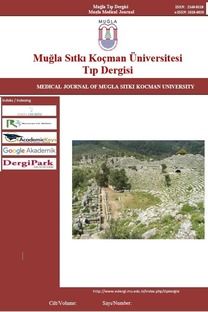Orofaringeal Tulareminin Tıbbi Görüntüleme Bulguları: Görüntüleme Bulgularının Tanısal Değeri
Görüntüleme, Lenf Nodları, Orofaringeal, Tularemi
Clinical Imaging Findings of Oropharyngeal Tularemia: The Diagnostic Value of Imaging Findings
Imaging, Lymph Nodes, Oropharyngeal, Tularemia,
___
- 1. Dennis DT, Inglesby TV, Henderson DA, et al. Tularemia as a biological weapon: medical and public health management. JAMA. 2001; 285(21):2763–73.
- 2. Karabay O, Yilmaz F, Gurcan S, Goksugur N. Medical image. Tularaemic cervical lymphadenopathy. N Z Med J. 2007 26;120(1248):U2403.
- 3. Penn RL. Francisella tularensis (tularaemia). In: Mandell GL, Bennett JE, Dolin R, editors. Principles and Practice of Infectious Diseases, 6th edn. New York: Churchill Livingstone; 2005. p. 2674-85.
- 4. Oztoprak N, Celebi G, Hekimoglu K, et al. Evaluation of cervical computed tomography findings in oropharyngeal tularaemia. Scand J Infect Dis. 2008;40(10):811-4.
- 5. Coscarón Blanco E, Martín Garrido EP, González Sánchez M, García García I. Clinical study on head and neck tularemia. Acta Otorrinolaringol Esp. 2009.60(1):25-31.
- 6. Som PM, Curtin HD, Mancuso AA. An imaging based classification for the cervical nodes designed as an adjunct to recent clinically based nodal classifications. Arch Otolaryngol Head Neck Surg. 1999;125(4):388-96.
- 7. Karadenizli A, Gurcan S, Kolayli F, Vahaboglu H. Outbreak of tularaemia in Golcuk, Turkey in 2005: report of 5 cases and an overview of the literature from Turkey. Scand J Infect Dis. 2005;37(10):712–6.
- 8. Jacobs RF. Tularemia. Adv Pediatr Infect Dis. 1997;12:55–69.
- 9. Robson CD. Imaging of granulomatous lesions of the neck in children. Radiol Clin North Am. 2000;38(5):969-77.
- 10. Kanlikama M, Gokalp A. Management of mycobacterial cervical lymphadenitis. World J Surg. 1997;21(5):516–9.
- 11. Stewart MG, Starke JR, Coker NJ. Nontuberculous mycobacterial infections of the head and neck. Arch Otolaryngol Head Neck Surg. 1994;120(8):873–6.
- ISSN: 2148-8118
- Yayın Aralığı: Yılda 3 Sayı
- Başlangıç: 2014
- Yayıncı: Muğla Sıtkı Koçman Üniversitesi
Deneysel Kronik Pankreatitte N-Asetil Sistein Uygulamasinin Pankreatik Fibroz Üzerine Etkisi
Ramazan ÖCAL, İlker TAŞÇI, M. Salih DEVECI, Bilgin CÖMERT, Ahmet Turan ISIK, M. Refik MAS
Plazmaferez Sırasında Fatal Seyreden TRALI
Canan GÜRSOY, Ezgi DÖNMEZ, Semra GÜMÜŞ DEMİRBİLEK
Otizm Spektrum Bozukluğu Olan Olgularda Anne Sütü Alım Süreleri ve Otizm Şiddetiyle İlişkisi
Nilfer ŞAHİN, Damla BALKAN, Ulviye KIRLI
Güray KOÇ, Semai BEK, Zeki GÖKÇİL
Farklı Tiroid Patolojilerinin Ayrımında Nötrofil Lenfosit Oranının Prediktif Rolü
İbrahim ATAK, Lütfi POLAT, Tuba ATAK
Ahmet GENÇ, Şevket GÖRGÜLÜ, Mehmet EREN
Sağ Akciğerde Horizontal Fissür Yokluğu
Mehmet İlkay KOŞAR, Ceren UĞUZ GENÇER, Hasan TETİKER
Orofaringeal Tulareminin Tıbbi Görüntüleme Bulguları: Görüntüleme Bulgularının Tanısal Değeri
Ömer KOÇAK, Aslı AYAN, A. Turan ILICA, Banu ÇAKIR, Yavuz ÇEKLİ, Dilek KÖSEHAN, Serdar KARAHATAY, Muhammet UZUN
Vücut Geliştiricide İntramuskuler Synthol Enjeksiyonuna Bağlı Lipoid Pnömoni
Nesrin ÖCAL, Armağan GÜNAL, Yakup ARSLAN, Berat KAÇMAZ, Ali COŞKUN, Bahadır Can KARAN, Deniz DOĞAN, Cantürk TAŞCI, Ergun UÇAR
